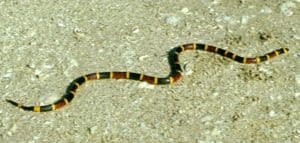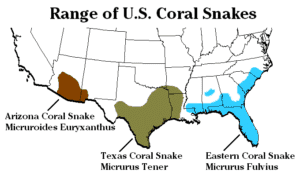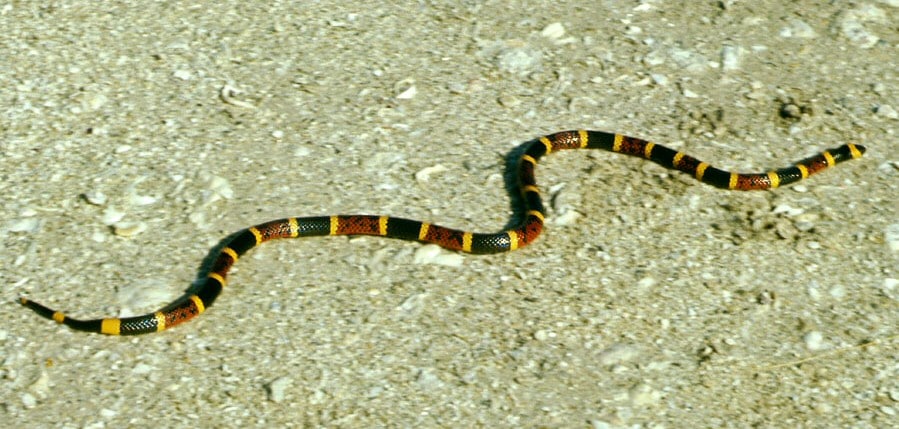
Coral snakes are one of the most interesting venomous native to the United States, and the only venomous snake species that is not a pit viper. While rattlesnakes, copperheads, and water moccasins all fall under pit viper, the brightly colored coral snakes are actually elapidaes (same family as cobras, black mambas, and many sea snakes), instead.
These snakes tend to be very small, thin, and mostly nocturnal in the U.S. They aren’t nearly as widespread as many people believe, seeing as how the overlapping king snakes who look similar have a much wider habitat including the same limited ranges where coral snakes can be found.
However, they hold a very potent venom and you definitely want to learn how to tell a coral snake from a king snake or how to tell a coral snake from a similar looking milk snake. Coral snake identification isn’t hard – and it can save you a lot of pain.
The Coral Snake Rhyme
There are a few variations, but this is the one I was taught and one that I think makes the most sense out of the versions I’ve heard:
Red touch yellow, kill a fellow
Red touch black, venom lack
The coral snake features rings and bands in black, red, and yellow, as does the non-venomous king snake and some milk snakes. This rhyme is how you can tell the two apart from one another. In coral snakes the red touches yellow. In the other snakes this is not the case.
Another example of the above coral snake rhyme is:
Red touch yellow, kill a fellow
Red touch black, friend of Jack
Important to note: the yellow can be thin lines (like in the pictures we have in this article) or they can be long thick bands can
Important Note: This rhyme only works with those in the United States area, as venomous coral snakes found in jungles and other parts of the Old World and New World will have different patterns including pink and red bands touching black, so don’t rely on this rhyme outside of the United States!

Where Are Each Found?
Pretty much anywhere that you can find coral snakes, you will also find similar looking king snakes and milk snakes, but the opposite is not true. A classic example is the California king snake found naturally throughout the state of California but coral snakes are not.
As you can see from this public domain map, there are three distinct populations of coral snakes found in the States, and are especially prevalent in Texas, the southeast, and a good chunk of Arizona.
Outside of these areas you are almost certainly looking at a non-venomous snake, however you should always run the rhyme through your head – it’s common sense prevention and caution, although the safest method is to always give a brightly colored snake wide ground.
Coral snakes aren’t aggressive by nature, but they will defend themselves if they are accidentally grabbed, stepped on, or are otherwise harassed or threatened. They have smaller fangs which means as long as you’re not grabbing them with bare skin chances are you’ll be in pretty good shape since their fangs have a hard time getting through really thick tough cloth or leather and simply can’t challenge a good pair of snake boots.
Get a LOT more information
If you want a lot more information on the coral snake in the United States, you should check out the 20,000+ words on venomous snakes native to the United States. We take pride in that post being one of the best online anywhere on the many venomous snakes found in the United States (often incorrectly called poisonous snakes) and check that out for detailed sections on all 3 species of coral snakes within the US.
Finally, if you’re worried about protection while having to walk through wetlands where coral snakes might be found, take a look at our pages on the best snake boots.
In Conclusion
Remember that when it doubt, just leave the snake alone! The far majority of snakes tend to be non-aggressive and are more than happy to leave you alone or even take off at the first sign of people. There have only been two deaths in 50 years and one of those was due to refusal to get treatment. These are beautiful snakes that aren’t a practical danger at all as long as they are left alone.

